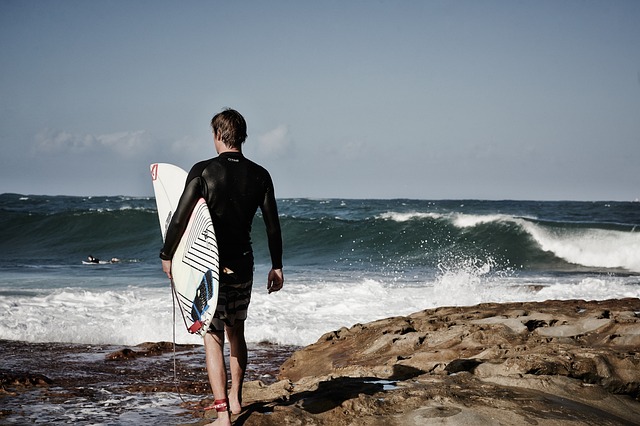Choosing the right surfboard finish is crucial for beginners, balancing performance, durability, and cost. Epoxy finishes offer superior strength, flexibility, and a glossy look but are pricier and require skill to apply. Fiberglass finishes provide a smoother, more affordable option with easier maintenance, ideal for newcomers mastering surfing skills. Both options require minimal upkeep, and proper storage is key for longevity. Cost and environmental impact should also be considered; fiberglass is generally more eco-friendly while epoxy is stronger. Ultimately, either finish can enhance performance and durability for beginner surfboards, catering to individual preferences and budgets.
“Looking to enhance your first surfboard? Understanding the finishes is key. This guide dives into the world of surfboard coatings, focusing on epoxy and fiberglass—popular choices for beginners and seasoned surfers alike. From material properties and application processes to cost comparisons and environmental impacts, we demystify these finishes. Whether you’re a novice or eager to upgrade, this article provides insights to help you make an informed decision for your ideal surfboard finish.”
Understanding Surfboard Finishes: An Overview

For surfboard for beginners, understanding the different finishes is a crucial step in choosing the right board. Surfboard finishes are essentially the protective coating on the surface of the board, designed to enhance performance and durability. Two popular options are epoxy and fiberglass. Epoxy finishes offer superior strength-to-weight ratio and flexibility, making them ideal for high-performance boards. On the other hand, fiberglass finishes provide a smoother, more glossy appearance, often preferred by beginners as they’re easier to maintain and generally less expensive.
Each finish has its unique characteristics that can significantly impact the board’s handling and overall experience. For surfboard for beginners, epoxy finishes may require a steeper learning curve due to their complexity but offer a wider range of customization. Fiberglass, while simpler, is more uniform and provides a reliable choice for those just starting out in surfing, ensuring they focus on mastering the sport rather than board maintenance.
What is Epoxy? Properties and Benefits

Epoxy is a versatile, two-part composite material that combines an resin and a hardener. When mixed together, it forms a strong, durable bond that can be used to finish various surfaces, including surfboards designed for beginners. This remarkable substance offers unique properties that make it a preferred choice in many industries, from marine applications to art projects.
One of the key benefits of epoxy is its exceptional strength-to-weight ratio. It provides an incredibly robust and rigid finish, ensuring surfboards are durable enough to withstand the rigors of beginner use, including constant contact with water and regular impacts during learning sessions. Additionally, epoxy has excellent adhesion properties, allowing it to bond well with various materials commonly used in surfboard construction, such as fiberglass. This feature simplifies the manufacturing process for surfboards, offering a seamless and long-lasting finish that contributes to improved board performance for newcomers to surfing.
Advantages of Epoxy Finish for Beginners

For surfboard for beginners, epoxy finish offers several advantages that make it an attractive choice. It provides a smooth and durable surface, which is crucial for enhancing the board’s performance in the water. Epoxy is known for its excellent bonding properties, ensuring the various layers of the surfboard stay tightly connected, resulting in a more robust structure. This feature is particularly beneficial for beginners who may be less experienced with handling their boards.
Another key advantage of epoxy finish is its versatility. It can be easily customized to achieve different aesthetics, allowing beginners to personalize their surfboards according to their preferences. Moreover, epoxy finishes are resistant to fading, chipping, and peeling, ensuring the board maintains its sleek look for longer periods, providing a reliable companion for countless surfing sessions.
Fiberglass: The Traditional Choice Explained

Fiberglass has long been the traditional choice for surfboard construction, especially among beginners. Its lightweight yet durable nature makes it an ideal material for boards designed to help newcomers catch their first waves. The process involves layering glass fibers impregnated with a resin, which hardens over time, creating a smooth and solid surface. This method allows for intricate designs and shapes, catering to various riding styles.
For surfboard beginners, fiberglass offers a blend of performance and affordability. It’s easy to maintain and repair, making it a popular option for those just starting their surfing journey. This traditional finish provides excellent buoyancy and flexibility, enabling easier maneuvers in the water—key factors for beginners looking to gain confidence and improve their skills on the surf’s first few encounters.
Choosing Between Epoxy and Fiberglass for Your First Board

When it comes to choosing a finish for your first surfboard, epoxy and fiberglass are two popular options that offer distinct advantages and considerations. For beginners, epoxy provides an excellent choice due to its ease of application and repair. Epoxy finishes are known for their smooth, glossy appearance and superior durability, making them ideal for withstanding the rigors of surfing. It allows for a more personalized design process as repairs can be made more easily, catering to those who want to experiment with their board’s aesthetics.
On the other hand, fiberglass is a traditional finish that offers a cost-effective solution without compromising performance. While it may not be as versatile in terms of color and repair as epoxy, fiberglass is renowned for its strength and stiffness, contributing to better board performance in the water. This finish is particularly appealing for those looking for a more affordable option without sacrificing the overall quality and longevity of their surfboard, making it a great choice for beginner surfers who want a reliable and durable ride.
Application Process: Step-by-Step Guide (Epoxy)

Application Process: Step-by-Step Guide (Epoxy)
For a surfboard for beginners, using epoxy as the finishing touch can significantly enhance its performance and durability. To apply epoxy, start by preparing your workspace. Ensure you’re in a well-ventilated area due to the strong odor of the resin. Gather all necessary tools: brushes, rollers, mixing containers, and protective gear like gloves and goggles.
Next, mix the epoxy according to the manufacturer’s instructions. Typically, this involves combining hardener with resin in specific proportions. Once mixed, apply a thin coat of epoxy onto the surfboard using a brush or roller. Allow it to cure slightly before adding another layer for maximum adhesion. Continue building up layers until you’ve achieved your desired finish, taking care not to oversaturate the board.
Maintenance and Care: Tips for Longevity

Epoxy and fiberglass finishes require minimal maintenance, making them ideal for surfboards designed for beginners who may not always have time or expertise for extensive care. Regular cleaning with mild soap and warm water is sufficient to keep your surfboard looking new. Avoid using harsh chemicals or abrasive materials as they can damage the finish.
To ensure longevity, store your surfboard properly when not in use. Keep it in a cool, dry place away from direct sunlight and extreme temperatures. Protect it with a cover or rack to prevent scratches and other physical damage. Additionally, be mindful of how you carry and transport your surfboard to avoid dings and chips in the finish, which can compromise its structural integrity, especially for those just starting their surfing journey.
Cost Comparison: Budgeting for Your Surfboard Finish

When considering the finish for your surfboard, one of the primary factors to keep in mind is the cost. Both epoxy and fiberglass finishes have their own financial implications, and understanding these early on can help beginners make an informed decision that fits their budget.
In general, epoxy finishes tend to be more expensive than fiberglass ones. This is primarily due to the specialized materials and skilled labor required for application. Epoxy offers superior durability and a smoother finish, which can be appealing for experienced surfers looking for high-performance gear. However, for surfboard for beginners, a fiberglass finish might be a more cost-effective choice, providing a solid and long-lasting protective layer without breaking the bank.
Environmental Impact: Sustainability Considerations

When choosing between epoxy and fiberglass finishes, especially for a surfboard designed for beginners, it’s crucial to consider the environmental impact and sustainability. Epoxy, while offering superior strength and durability, has drawbacks in terms of production and disposal. It contains toxic components that can harm both human health and marine ecosystems if not properly managed. In contrast, fiberglass is more environmentally friendly during manufacturing but may degrade over time, posing challenges for eco-friendly disposal.
For surfboards intended for beginners looking to enjoy the ocean responsibly, fiberglass is often the preferred choice due to its lower environmental impact. However, it’s essential to remember that proper disposal and recycling practices are vital to minimizing the ecological footprint of either material. As a beginner surfer, making an informed decision about your surfboard’s finish not only contributes to sustainability but also ensures you have a positive experience in the water, knowing your choice aligns with responsible environmental stewardship.
